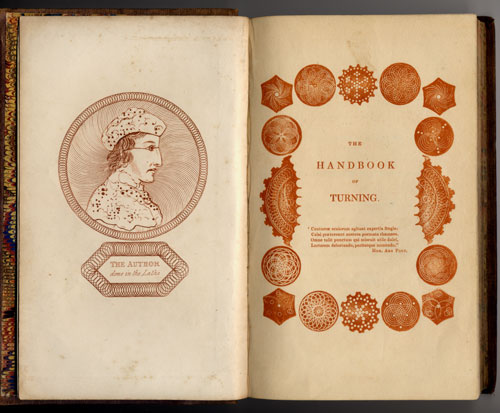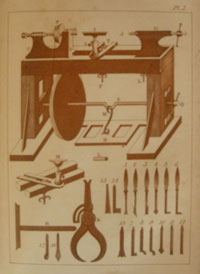 I was reading Chris Schwarz's recent blog entry on his favorite woodworking writer Mag Ruffman and it reminded me that I have been planning to write an entry about the first women woodworking writer. At least the first one I am aware of. The Handbook of Turning was first published anonymously in 1842 but it is generally considered the work of one Miss Gascoigne of Parlington Park, near Leeds. A very rich women, from a powerful family, when she married her husband took her last name. Ornamental turning was apparently her hobby. The book contains all the basics of ornamental turning and was a popular resource and both reprinted (the illustrations are from the second edition) and pirated for many years. I was reading Chris Schwarz's recent blog entry on his favorite woodworking writer Mag Ruffman and it reminded me that I have been planning to write an entry about the first women woodworking writer. At least the first one I am aware of. The Handbook of Turning was first published anonymously in 1842 but it is generally considered the work of one Miss Gascoigne of Parlington Park, near Leeds. A very rich women, from a powerful family, when she married her husband took her last name. Ornamental turning was apparently her hobby. The book contains all the basics of ornamental turning and was a popular resource and both reprinted (the illustrations are from the second edition) and pirated for many years.
 Furniture making was just emerging a hobby in the 1840's, the middle class still needed more free time to become do-it-yourselfers, but ornamental turning was one of the few craft hobbies of royalty and the gentry of the 19th century and earlier. Companies like Holtzapffel & Co. made incredible foot powered lathes for the purpose. It's would have been uncommon but not unheard of for a women of means to turn. The real impediment would have been the considerable cost of the lathe, which is why ornamental turning was the hobby of very rich people. Furniture making was just emerging a hobby in the 1840's, the middle class still needed more free time to become do-it-yourselfers, but ornamental turning was one of the few craft hobbies of royalty and the gentry of the 19th century and earlier. Companies like Holtzapffel & Co. made incredible foot powered lathes for the purpose. It's would have been uncommon but not unheard of for a women of means to turn. The real impediment would have been the considerable cost of the lathe, which is why ornamental turning was the hobby of very rich people.
On the professional level almost all the women owning shops and in the cabinet trade would have inherited the business from their husbands or fathers and would mostly have been in the administrative side of the business. However, at the time there was at least one woman sawyer in London (source: Henry Mayhew) and for all the modern talk about women staying home and raising children in Victorian times, women worked in all the craft industries, usually in jobs that required dexterity but not huge amounts of strength. Women were typically paid less than men which was a big incentive for factory owners to hire women, and a reason why the jobs were so segregated. The subject of women in the woodworking trades really requires a detailed study, which I haven't done, but certainly when you research 19th century industry it's a lot closer to today when most women are in the workplace rather than say 50 years ago when they weren't.
According to the caption the picture of the author above was made on the lathe - which is kind of cool. I do apologize for the poor scan of the lathe. The book binding is fragile and I could not put that page on the scanner.
|
 Joel's Blog
Joel's Blog Built-It Blog
Built-It Blog Video Roundup
Video Roundup Classes & Events
Classes & Events Work Magazine
Work Magazine


 I was reading
I was reading  Furniture making was just emerging a hobby in the 1840's, the middle class still needed more free time to become do-it-yourselfers, but ornamental turning was one of the few craft hobbies of royalty and the gentry of the 19th century and earlier. Companies like
Furniture making was just emerging a hobby in the 1840's, the middle class still needed more free time to become do-it-yourselfers, but ornamental turning was one of the few craft hobbies of royalty and the gentry of the 19th century and earlier. Companies like
Stephen
Regards Ray
Ps. Making them yourself is what Ornamental Turning is all about.